
About UsThe Numismatic Bibliomania Society is a non-profit organization promoting numismatic literature. For more information please see our web site at coinbooks.org SubscriptionsThose wishing to become new E-Sylum subscribers (or wishing to Unsubscribe) can go to the following web page link MembershipThere is a membership application available on the web site Membership Application To join, print the application and return it with your check to the address printed on the application. Membership is only $15 to addresses in the U.S., $20 for First Class mail, and $25 elsewhere. For those without web access, write to: David M. Sundman, Treasurer AsylumFor Asylum mailing address changes and other membership questions, contact David at this email address: dsundman@LittletonCoin.com SubmissionsTo submit items for publication in The E-Sylum, just Reply to this message, or write to the Editor at this address: whomren@gmail.com
BUY THE BOOK BEFORE THE COIN |
- WAYNE'S WORDS: THE E-SYLUM MARCH 16, 2014
- HERITAGE TO OFFER 1850 ECKFELDT-DUBOIS WITH GOLD SAMPLE
- MORE ON JEAN-PAUL DIVO
- REMEMBERING LOUIS HUDSON
- NOTES FROM E-SYLUM READERS: MARCH 16, 2014
- 1936 NOBEL PEACE PRIZE TO BE AUCTIONED
- THOMAS MACHIN'S SIGNATURE FOUND
- THE JOURNALS OF ALFRED DOTEN, 1849-1903
- ON THE SIGNIFICANCE OF FOUND COINS
- BALD PEOPLE ON COINS
- OLDEST AUSTRALIAN BANKNOTE TO BE SOLD
- MORE NUMISMATIC QUOTES
- WAYNE'S NUMISMATIC DIARY: MARCH 16, 2014
- TOM KAYS' NUMISMATIC DIARY: MARCH 11, 2014
- DICK JOHNSON ON DIVIDING A FAMILY COIN COLLECTION
- THE NUMISMATOURIST REPORT: MARCH 16, 2014
- MAN CREATES U.S. MAP MADE OF 24,000 PENNIES
- THE FIRST ELECTRICITY BILL: THOMAS EDISON'S DOLLAR
- BANK OF INDIA NOTES NOT IN ERROR
- FAT PETE AND AUSTRALIA’S BIGGEST COUNTERFEIT MONEY OPERATION
Click here to access the complete archive
To comment or submit articles, reply to whomren@gmail.com
WAYNE'S WORDS: THE E-SYLUM MARCH 16, 2014

New subscribers this week include Philliph Degens, courtesy of Howard Daniel. Welcome aboard! We have 1,711 email subscribers.
This week we open with Heritage's upcoming sale of a rare 1850 book containing samples of California gold dust, and remembrances of numismatists Jean-Paul Divo and Louis Hudson.
Other topics include a rare Nobel Peace Prize medal, Thomas Machins' signature, the oldest Australian banknote, and numismatic diaries from Tom Kays and Numismatourist Howard Berlin.
To learn more about the Monty Python medal, bald people on coins, terminus ante quem, bovine numismatists, and Fat Pete and the Purple banknotes, read on. Have a great week, everyone!
Wayne Homren
Editor, The E-Sylum
HERITAGE TO OFFER 1850 ECKFELDT-DUBOIS WITH GOLD SAMPLE
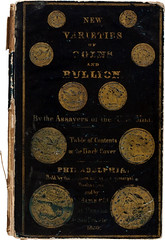 The rare book division of Heritage Auctions currently has an 1850 copy of New Varieties of Gold and Silver Coins by Eckfeldt and Dubois, with the gold samples on page 45. This is a presentation copy to George W. Edelman, deputy treasurer of the U.S. Assay Office in New York. Internet bidding ends on April 1, and this is not an April Fool’s joke! The live auction will follow the next day in New York City
The rare book division of Heritage Auctions currently has an 1850 copy of New Varieties of Gold and Silver Coins by Eckfeldt and Dubois, with the gold samples on page 45. This is a presentation copy to George W. Edelman, deputy treasurer of the U.S. Assay Office in New York. Internet bidding ends on April 1, and this is not an April Fool’s joke! The live auction will follow the next day in New York City
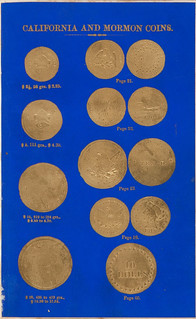

To read the complete lot description, see: Lot 36139 [Gold Rush]. Jacob R. Eckfeldt and William E. Du Bois. New Varieties of Gold and Silver Coins, Counterfeit Coins, ... (historical.ha.com/c/item.zx?saleNo=6108&lotNo=36139)

MORE ON JEAN-PAUL DIVO
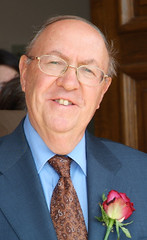 Jean-Paul Divo was born in Luxemburg on August 8, 1937 and passed away on 13. 2. 2014. His interest in literature, art and history was „placed in his cradle“ by his parents. As a schoolboy one could find him in the fields around Luxemburg where, at that time, one could literally pick up Roman coins from the ground. The evenings were spent with cataloguing the thus found coins. He became acquainted with Romain Probst, later a coin dealer, and the scholar Raymond Weiler in the Luxemburg Numismatic Association. These were to become friendships that lasted a lifetime.
Jean-Paul Divo was born in Luxemburg on August 8, 1937 and passed away on 13. 2. 2014. His interest in literature, art and history was „placed in his cradle“ by his parents. As a schoolboy one could find him in the fields around Luxemburg where, at that time, one could literally pick up Roman coins from the ground. The evenings were spent with cataloguing the thus found coins. He became acquainted with Romain Probst, later a coin dealer, and the scholar Raymond Weiler in the Luxemburg Numismatic Association. These were to become friendships that lasted a lifetime.
Having finished his military service in 1958 he answered an advertisement for a coin dealer by the firm of Seaby’s in London and was accepted. This was the beginning of a great numismatic life. His occupational career was varied and international in scope. He first worked for the classical firms of Seaby’s, Bank Leu and Spink (there as business manager of the Zurich office), then as partner with the Hess-Divo AG (formerly Adolph Hess AG).
It is remarkable that he found the time and energy to write so many books and articles, aside from the many auction catalogues. Some of these will remain standard works for generations. They mirror his great and broad numismatic knowledge.
With Edwin Tobler he wrote the standard reference books for Swiss coins since the 17th century. But he also was interested in the coins of modern Greece, Great Britain, and towards the end of his life, France and Alsace. He wrote two books on French medals with the collaboration of his wife, Françoise Page-Divo. The author of this obituary was also impressed by his knowledge and interest for the small, sometimes obscure areas of numismatics.
He spoke fluent German, French, Luxemburg Dialect, English and Italian. He even learned rudimentary Japanese through his work as business manager for Spink-Taisei, thus being able to conduct several auctions in Tokyo. Readers of the Swiss magazine NumisPost knew him as Ovid, who sent monthly letters from Paris. He reported about the French numismatic market, museums, personalities and everything that was of interest to collectors.
To read the complete article, see: Jean-Paul Divo (1937-2014) (www.coinsweekly.com/en/News/4?&id=2654)
REMEMBERING LOUIS HUDSON
Howard Daniel writes:
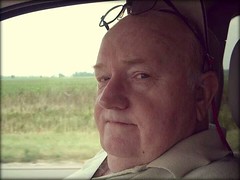 I cannot remember the first numismatic show I met Lou Hudson at but it was likely my first International Paper Money Show in Memphis, which was the last one held at the Holiday Inn. The picture of him in The E-Sylum is a classic Hudson look! That first time I believe I saw that look was when I bought some chopmarked Spanish colonial coins from him. He started questioning me about my knowledge about the coins under the chops and I knew very little. He immediately started to teach me about them at that show and others.
I cannot remember the first numismatic show I met Lou Hudson at but it was likely my first International Paper Money Show in Memphis, which was the last one held at the Holiday Inn. The picture of him in The E-Sylum is a classic Hudson look! That first time I believe I saw that look was when I bought some chopmarked Spanish colonial coins from him. He started questioning me about my knowledge about the coins under the chops and I knew very little. He immediately started to teach me about them at that show and others.
We soon realized we could insult each other with gusto and still get along, and we especially did it at every Memphis, which shocked anyone close to us. When his health started going the wrong way, his daughter started to accompany him. She could not handle our banter so we stopped doing it, but we always had a good handshake and he would growl something under his breath. My sympathies go to her and his other relatives. It will be a long time for me to forget to look for Lou at Memphis and other shows!
To read the complete article, see: LOUIS HUDSON, 1942-2014 (www.coinbooks.org/esylum_v17n10a07.html)
THE BOOK BAZARRE
NOTES FROM E-SYLUM READERS: MARCH 16, 2014
Remembering John Burns at Central States Bruce Perdue writes:
At the Central States 75th Anniversary Convention there will be the "John H. Burns Memorial Remembrance Booth" It will be used for book signings and for visitors to come by and remember John. The booth is the one John would have been at for the show.
To read the earlier E-Sylum article, see: UPDATE ON THE JOHN BURNS ESTATE (www.coinbooks.org/esylum_v17n10a08.html)
The Monty Python Medal Fred Michaelson writes:
You know how when you see something for the first tenth of a second your eyes tell your brain something, but then you realize that's not what it really is? This happened to me when I read last week's E-Sylum and came upon the words Franklin-Monthyon Medal. I thought it was saying Monty Python.
I noted that "The medal was stamped with a giant cartoon foot…"
Fred adds:
I can just see it: animation about what goes on at the Mint. Wasn't that Terry Gilliam stuff great? See ya later---I've gotta go to the cheese shop and get some Venezuelan beaver cheese...
To read the earlier E-Sylum article, see: NOTES FROM E-SYLUM READERS: MARCH 2, 2014 : Franklin-Monthyon Medal (www.coinbooks.org/esylum_v17n09a11.html)
EMPLOYMENT OPPORTUNITY!
Live and Work in Southern CaliforniaStack’s Bowers Galleries offers an important employment opportunity for the right person. We are seeking an experienced numismatist in the American series—coins, tokens, medals, and paper money—to work with our “dream team” of catalogers, building on the tradition of the Ford, Eliasberg, Bass, Cardinal, Norweb, Battle Born and other great collections.
If you can write in an authoritative and compelling manner with a high degree of accuracy, this may be just right for you! You will be working in Irvine, a modern community in dynamic Orange County, California—one of the finest areas to live. We offer generous benefits including medical and dental coverage, 401K plan, and more. Our offices are in our own modern, state-of-the art building with all amenities.
If you would like to be considered for this position please contact Q. David Bowers by mail or by email with your resumé, samples of your past writing (on numismatics or other subjects), and salary requirements: Mail to the attention of Q. David Bowers, PO Box 1804, Wolfeboro, NH 03894. Email to: Ckarstedt@stacksbowers.com
1936 NOBEL PEACE PRIZE TO BE AUCTIONED
A 1936 Nobel Peace Prize discovered at a South American pawn shop is heading to the auction block in the U.S.
The 1936 Nobel Peace Prize recipient was Argentina's foreign minister, Carlos Saavedra Lamas, who was honored for his role in negotiating the end of the Chaco War between Paraguay and Bolivia. In the decades after his death, the whereabouts of the piece "fell into darkness," said John Kraljevich, a specialist in historical medals and a consultant to Stack's Bowers. Then some 20 years ago, an American collector got word of the medal showing up in a South American pawn shop, where it was purchased for the value of its gold.
The award will be only the second Nobel Peace Prize to come to auction and marked the first time an individual from Latin America had received the honor.
The New York-based Stack's Bowers Galleries is offering it for sale March 27 in Baltimore.
The 23-karat relic weighs 222.4 grams, which in today's market would make it worth $9,168 for the gold alone. As an object to collectors and world history, its value is much greater.
"I can't think of many public collections that have a Nobel Prize, never mind a Nobel Peace Prize medal," said Ute Wartenberg, executive director of the American Numismatic Society. "This is an incredible rarity."
The auction also includes the first Pulitzer Prize for Public Service to come to auction. The 14-karat gold medallion was presented to the now-defunct New York World-Telegram in 1932.
The Peace Prize is one of five Nobel awards created by the Swedish industrialist and inventor Alfred Nobel along with recognitions in chemistry, physics, medicine and literature.
A tiny file mark found on the Nobel Peace medal's edge likely was made to determine its worth.
"Back then, you'd grind a little piece off to figure out just how fine the gold was," Kraljevich said. "Had the shop owner not recognized that it might be worth more to somebody than just the value of the bullion ... it would have been melted and thrown in with broken gold earrings."
The medal changed hands several more times until it was purchased by another American collector, whose estate is now selling it.
To read the complete article, see: 1936 Nobel Peace Prize to be auctioned in Maryland (www.nzherald.co.nz/world/news/article.cfm?c_id=2&objectid=11218681)
THOMAS MACHIN'S SIGNATURE FOUND

Machin's Mills partnership agreement
Roger Siboni writes:
It doesn't get more authentic than this and it's housed in the ANS. Amazing to even hold it in your hand.
Referring to the same document, Phil Mossman referred us to page 187 of his book, Money of the American Colonies and Confederation.
Phil writes:
Below is a copy of Thomas Machin's signature from the April 18, 1787 partnership agreement with James Atlee and four others to mint NY coins at Newburgh. This is sent with the permission of the ANS (I asked). The smudge is the wax impression.

Courtesy of the American Numismatic Society
Thanks, everyone. What a great document!
To read the complete article, see: NOTES FROM E-SYLUM READERS: MARCH 9, 2014 : Query: Thomas Machin Signature Sought (www.coinbooks.org/esylum_v17n10a10.html)
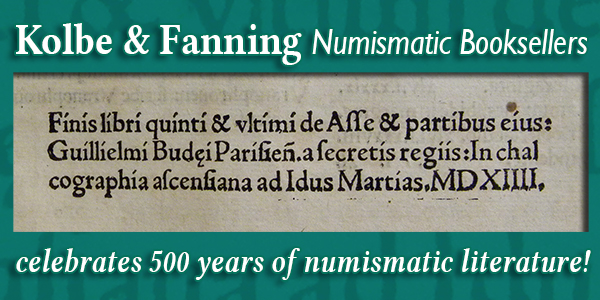
THE JOURNALS OF ALFRED DOTEN, 1849-1903
Me Back to the Carson City Mint’s Glory Days
By Mark W. Archambault
#LM-28-0335
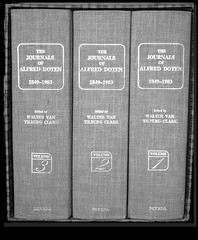 After reading Rusty Goe’s article about “Deep Participation – Going Below the Surface of Carson City Coin Collecting” in the spring 2013 edition of Curry’s Chronicle, I began searching for other avenues beyond the coins to quench my appetite for all things related to the life and times of the Carson City Mint and the famed Comstock Lode. I decided to focus on the years of operation at the Carson City Mint and the boom years on the Comstock Lode.
After reading Rusty Goe’s article about “Deep Participation – Going Below the Surface of Carson City Coin Collecting” in the spring 2013 edition of Curry’s Chronicle, I began searching for other avenues beyond the coins to quench my appetite for all things related to the life and times of the Carson City Mint and the famed Comstock Lode. I decided to focus on the years of operation at the Carson City Mint and the boom years on the Comstock Lode.
One of these searches ended with the purchase of a three-volume set of Alfred Doten’s journals, published by the University of Nevada, Reno. In these journals, Mr. Doten documents daily his adventures beginning as a 19-year-old who set sail from Massachusetts on March 18, 1849 to California. His writings chronicle his life in the gold fields and his move to Washoe, another name for Nevada Territory.
Doten’s life story tell us about his friends, including Abraham Curry, who gave Doten one of the first silver dollars struck in 1870 with that fascinating “CC” mintmark that we all cherish. Doten also writes about his acquaintance with Superintendent James Crawford, and a meeting with Crawford at the Carson Mint.
As I began reading this massive 2,400+-page compilation of his life, I found myself living his experiences through his eyes; and what an interesting view it is. I am now wondering where this adventure may take me as I learn about the people Doten writes about in his journals, and how far I would like to take my research. It sounds like it will be a whole lot of fun; but isn’t this what it’s all about? I look forward to sharing future discoveries with you.
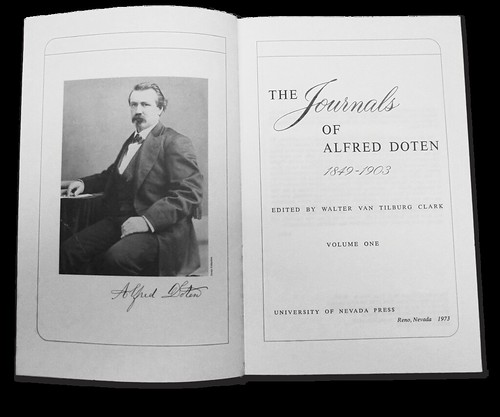
For those of us who were fortunate to be at the Nevada State Museum on August 23, 2013 to listen to Rusty Goe’s lecture about “Ten Non-Coin Collectibles Every ‘CC’ Coin Enthusiast Should Own,” you know we were treated to a real education that will surely give us more avenues to explore and collect. I hope that all of you reading this article find and enjoy the various paths of fulfillment in building your own collections, which go beyond the coins, as I have.
References:
The Journals of Alfred Doten, 1849-1903, edited by Walter Van Tilburg Clark, University of Nevada Reno
“Deep Participation – Going Below the Surface of Carson City Coin Collecting,” by Rusty Goe, Spring 2013 Curry’s Chronicle
“Ten Non-Coin Collectibles Every ‘CC’ Coin Enthusiast Should Own,” Rusty Goe’s lecture August 23, 2013, Nevada State Museum
(Images courtesy of Southgate Coins)
For more information, or to join CCCCOA, see: www.carsoncitycoinclub.com
ON THE SIGNIFICANCE OF FOUND COINS
Tom DeLorey writes:
 The find of an English coin of Elizabeth I in British Columbia is interesting, but without any proper archaeological documentation it means nothing. Over the years I have carried a variety of pocket pieces, dating back as far as a Roman denarius, but when I lost them, as I inevitably have save for the 1950 Railroad five pesos I am currently carrying, it was never in the year the coin was made or even the years that it was still current.
The find of an English coin of Elizabeth I in British Columbia is interesting, but without any proper archaeological documentation it means nothing. Over the years I have carried a variety of pocket pieces, dating back as far as a Roman denarius, but when I lost them, as I inevitably have save for the 1950 Railroad five pesos I am currently carrying, it was never in the year the coin was made or even the years that it was still current.
On the Yahoo Colonial Coin group, David Menchell wrote:
I doubt that the coin was placed there contemporaneously. The earliest European explorer to the area was Juan de Fuca; the British didn't get there until years later under James Cook and George Vancouver in the late 18th century. As far as the Vikings are concerned, they were busy on the coast of Labrador but didn't appear to venture farther south or west, certainly not on the Pacific coast.
Here's another coin found in an unusual location. David Powell forwarded the following snippet from The Numismatic Chronicle of 1922:

David writes:
As for the most bizarre and farflung findspot recorded for a British 17th cent token, Robert Thompson some years ago drew my attention to "a Reuters report entitled "Disc dated 1657 found inside shark", viz. the stomach of a five-foot shark caught off Galveston, Texas, in 1931, reported in the Morning Post of 9 September 1931, p.13, col.1, and followed by a letter on 12 September from A. J. Wood of Canterbury. The upshot was that the disc was identified as a specimen of Williamson's Kent 452, Richard Langley of Ramsgate."
To read the complete article, see: EDWARD VI SHILLING FOUND VICTORIA, BRITISH COLUMBIA (www.coinbooks.org/esylum_v17n10a23.html)
BALD PEOPLE ON COINS
Regarding Hubert Walker's query about bald people on coins, Justin Perrault writes:
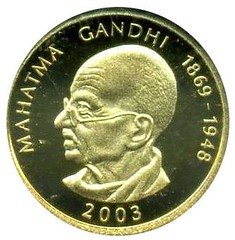 Just thought I would pass along my suggestion on coins featuring the follicly impaired. There are a number of coins that feature Mahatma Gandhi, namely this one from Samoa.
Just thought I would pass along my suggestion on coins featuring the follicly impaired. There are a number of coins that feature Mahatma Gandhi, namely this one from Samoa.
To read the complete article, see: Mahatma Gandhi (1869-1948) - Samoa - 2003 - commemorative gold coin (www.kazcoins.com/?513,mahatma-gandhi-(1869-1948)-samoa-2003-commemorative-gold-coin)
Louis Caravella writes:
Regarding your reader’s question on bald men on coins, I’d point you to Galba, who was about 70 years old when he was Emperor of Rome in the bloody Year of the Four Emperors (AD 69). He was likely bald and sure looks bald in the sculpture on his Wikipedia page. Many coins depict him with hair, but there are a few that seem to celebrate the dome, such as RIC I, 13.
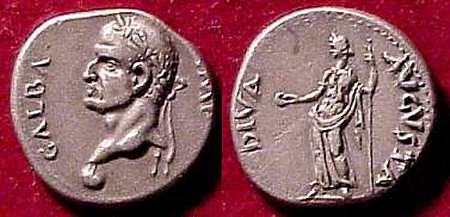
http://www.wildwinds.com/coins/ric/galba/RIC_0013.jpg
To read the complete article, see: QUERY: BALD PEOPLE ON COINS (www.coinbooks.org/esylum_v17n10a22.html)

OLDEST AUSTRALIAN BANKNOTE TO BE SOLD
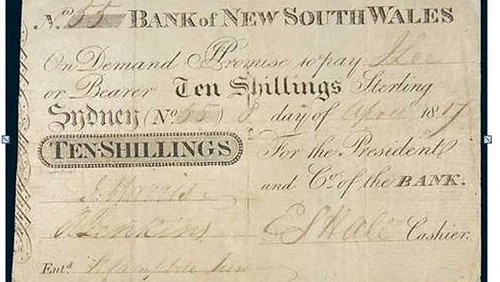
AUSTRALIA’S oldest paper money will go under the hammer in Sydney later this month.
The only known specimen of the first official banknote issued in Australia was uncovered in a private collection in Scotland.
The ten shilling note, issued on the order of the NSW Governor in 1817 by the Bank of New South Wales (now Westpac) on the day the bank opened, is expected to attract bids from investors and collectors around the world.
“We have put a conservative estimate of a quarter of a million dollars on it in the catalogue,” said Jim Noble of Noble Numismatics.
When Lieutenant-Colonel Lachlan Macquarie arrived in Sydney in 1809 he discovered a lack of a stable monetary system. A provisional local currency had evolved including promissory notes that were easily forged and often dishonoured, a mixture of overseas coins brought to the colony by visiting ships, and anything that could be used for barter, especially rum.
In 1816, Macquarie pushed ahead with plans to establish a bank without first gaining approval from London.
On March 22, 1817, the charter for the first bank in Australia signed by Governor Macquarie, was delivered to the bank’s President.
On April 8, 1817 the Bank of New South Wales opened for business at 10am with 100 ten shillings notes issued on the first day.
In accordance with a decision recorded in the bank’s minutes of that day, all notes were made payable to ‘J. Lee or bearer’.
To read the complete article, see: The only surviving example of the first paper money issued in Australia to go under the hammer (www.news.com.au/national/nsw-act/the-only-surviving-example-of-the-first-paper-money-issued-in-australia-to-go-under-the-hammer/story-fnii5s3x-1226852603188)
MORE NUMISMATIC QUOTES
Regarding our call for old and new quotes about numismatics, David Powell offers:
1st small boy: "My dad's a numismatist"
2nd small boy: "What does that mean?"
1st small boy: "He collects money"
2nd small boy: "Where I come from, we call them beggars"
David adds:
I can't remember the source of the quote. Somebody told me the joke at a coin club meeting a while back, but I can't remember who it was. I doubt that it was original.
George Huber writes:
My own personal numismatic quote, as seen on my website (www.VDBCoins.com), is original to me: “Life is too short to buy ugly coins.”
Hardly undying prose, but it has an Anglo-Saxon pithiness I like.
To read the earlier E-Sylum article, see:
On Tuesday morning I fielded a nice call from Charles Morgan of CoinWeek. Long story short, they're going to start linking to The E-Sylum each week and will also be taking some ads. We welcome the additional exposure this major site can bring to our forum, which I've described as a weekly cocktail party with some of the best numismatists in the world. Our casual conversation veers from one interesting topic to another, with breaking news and numismatic questions, asides from the top experts, and wisecracks from the peanut gallery. Welcome, CoinWeek readers!
Tuesday evening was the night of my northern Virginia numismatic social group, Nummis Nova. I'd brought along several items from my collection of work from money artist J.S.G. Boggs, including some wearable items, in accordance with the evening's theme. My fellow dinner companions chipped in to record the festivities, so my diary is a short one this week.
My weekend was a busy one; Friday afternoon I travelled to the Pittsburgh area to help Pat McBride sort through the numismatic literature at the home of the late dealer John H. Burns. My old friends Ed Krivoniak and Tom Fort were also there helping, and it was great to catch up. After working from my arrival to about 9pm, Pat and I adjoined to a nearby bar for beers and food. My wife and kids were also in town for the weekend and I joined up with them at our hotel.
We attended a family event on Saturday. We split up again Sunday and I spent the morning working on the Burns estate before hitting the road around 1:30. Back here in Virginia I've been working on The E-Sylum since coming home from dinner, and better call it a night. Enjoy the rest of the issue!
Steve ordered up a side of numismatic humor. Numismatic humor is a tall order since fiscal jocularity and dry / dusty coin collectors are usually very distant relations. Coin collectors may be characters, but usually not comics. Jokes that only a coin collector would get was Steve’s objective, the more arcane the better. Now most everyone could think of jokes that had to do with money in a general sense, but not in the numismatic sense. The best “imported” joke, transcribed from an old story about horse trading, but instead of the old cow, insert an early American copper (Sheldon-272 I believe it was), as told by the nattily attired, Mike Packard, who may have an R-9 there. It was a long joke which only Mike can tell. Ask him!
From “ha ha” funny jokes to mere “fun,” this delightful dime scrip to the Flip-Flap Railway on Young’s Pier at Atlantic City invites us to spill our silver in the sand.
Aligned with the idea of funny money Wayne presented impressive J.S.G. Boggs five dollar notes for the “Considerate State of America” and signed by Wayne Homren as registrar of bogus bills.
Here we see another of those “rebelbux” of James Steven George Boggs.
Present were many Nummis Nova regulars plus an invited mystery guest. Gregg Coburn, one of the Board of Directors of the Virginia Numismatic Association (VNA), who forsook his usual Tuesday night banana split with the missus to be present, under the sponsorship of Wayne Herndon, sat at my end of the table. Gregg swapped fish stories and foreign coin tales having served his numismatic apprenticeship with coin dealer George Watson (another VNA Director) whom he met years ago, sailing with the Navy somewhere along the Pacific Rim, and again after twenty years their paths crossed at a local coin show.
Gregg now serves as a trusted minion in the warehouse vaults of Wizard Coin Supply. The mustachioed, grand vizier of Wizard Coin Supply, himself, presided at the head of the table, telling us how as a youngster, living on a mohair farm, beyond the farthest outskirts of San Antonio, Texas; living so far out that neither television nor radio signals would reach his hacienda, that little distractions of boyhood, such as those advertisements in the back of comic books, promising to bring X-ray glasses, ant farms, sea monkeys, and foreign coins for a dime or a nickel, all the way home, to the one’s rural mailbox; that those enticements loomed large in the imagination of farm boys. Now the next nearest “occupied” house was ten miles away, school thirty miles away, the nearest small town forty miles away, and the big city a hundred miles distant, yet rural delivery happened regularly, by a mailman serving two small Texas towns, a hundred miles apart, including one special mohair hacienda back in the foothills.
One fateful day an errant copy of Coin World, intended for a namesake forty miles further on, landed at the hacienda mailbox. You could buy and sell coins by mail? Filling out the subscription card that farm boy entered the exciting and fast paced world of numismatics, as a purveyor of mail-order rolls of wheat pennies, selling the duplicates to all his school chums. From those humble beginnings grew the vast Wizard Coin Supply empire of today. All around my end of the table we gave thanks the postman did not deliver in error, a copy of Lynn’s Stamp News, back on that fateful day in Texas.
Looking down the table to the more dour end, (I say this since they asked me not to tell any more jokes after the “stud finder” joke went south), and coming back to numismatic reality, swimming along the table came a small school of magnificent thalers.
Included was this beautiful 1729 Thaler of Johann Ernst VIII of Saxe-Saalfeld, issued on his death, with sarcophagus on the reverse, from the collection of Virgil Brand (Dav 2749).
Another thaler from 1710 Brunswick-Wolfenbuttel of Anton Ulrich, was issued on his conversion to Catholicism, and so, does not feature the usual “Wildman” but the rock “of faith,” also from the collection of Virgil Brand (Dav 2121).
Dave adds this note about the Talers:
All are from a 1965 sale of the Virgil Brand collection. Here are the details:
1710 Brunswick Wolfenbuttel. : An undated taler issued in 1710 on Anton Ulrich’s conversion to Catholicism. Davenport 2121
1729 Saxe-Saalfeld. Johann Ernst VIII, issued on his death. Date in a chronogram. Davenport 2749
1732 Windisch-Gratz. Leopold Viktorin Johann. Davenport 1202
Many other fine numismatic items floated past from proof-like silver dollars, to medals, to a collection of hard times tokens with counter stamps, as does happen when all our show and tells collide, but it is that wild profusion of interesting items stacking up to one’s left or right, that ensures each evening we convene, there will be something new with that “Wow factor” worth seeing.
Along with binders of numismatic ephemera, more T-shirts not modeled, an imitation 1861 quarter eagle button, and a Garrett Pro-Pointer (of interest to the Wizard folks who may soon offer a wider range of supplies), I saw an early 19th century “patent” floating along. Not a patent for invention, but an 1807 land grant for a lot in the Town of Erie, as enacted by the General Assembly of the Commonwealth of Pennsylvania, and surveyed in 1795. Title transferred from Thomas McKean, Governor, to George Burgess of Bucks County for twelve dollars.
Now Mike told me something interesting about one of the two founding families of Erie, Pennsylvania, Seth Reed. In 1786 Seth Reed petitioned the Massachusetts Legislature for the right to mint coins for Massachusetts, in competition with a rival petition by James Swann. The committee thought that making coins for the Commonwealth should easily amass the maker a tidy profit of perhaps 50% (not considering expenses), and so in May 1787, Seth Reed was denied the mint master position he sought. Seth determined to leave Massachusetts and became a surveyor at Geneva, New York, where he ran into difficulty in sharp trade with Native Americans. He vamoosed to Buffalo, and later went on to become one of the two founding families of Erie, Pennsylvania.
Seth Reed, neighbor to the newcomer George Burgess, is important to American numismatics being credited with adopting something used on American coinage. Do you know what the coin connection is with Seth Reed, co-founder of Erie, Pa?
Answer: .yadot-desu-llits-mvnv-subirulp-e-:ottom-eht-htiw-detiderc-si-deeR-hteS-,ekiM-ot-gnidroccA
I brought a couple of items, though they weren't on the theme for the dinner. I brought a ledger from the grist mill located in Mount Solon, Virginia from the 'teens to show Dave. It contains some interesting entries for a number of Western Virginia general stores that have proven useful in token cataloging. One entry in particular for the L. W. Shoulder & Co. store located in Doe Hill in Highland County includes a neat notation that it went bankrupt in June of 1913, thus providing what archaeologists would call a terminus ante quem, that is, the latest period the tokens from that store would have been used. Sometimes one of a kind materials such as store ledgers can add information that otherwise would have gone forgotten. Sometimes it pays to look for numismatic information in off-beat locations.
I also brought some tokens to show a few of my fellow exonumists. For Aaron, I brought a trio of high grade Virginia storecards including a lovely brass storecard issued by Charles Raine in Lynchburg dated 1860. He recently purchased an example of this popular token, so we enjoyed comparing notes on them. I also brought a pair of James Wolff tokens from Petersburg, one in brass and one in copper.
For local color closer to home, I also brought the only token from Loudoun County I have in my collection, a lovely silver dollar size aluminum good-for from the Loudoun Clothing House in nearby Leesburg. I have a particular affinity for this token because it is high grade, it is in a nice large size, has quite a bit of information from it (it hits all the major bits: store name, store owner's name, what they sold, and town name), and is also from a town in which I have spent much time in my working life. The building still exists at the corner of Market St. and King St. Part of the joy I get in collecting such tokens is the personal association I have with many of these places, as well as being able to put a human element to the pieces.
ADVICE TO THE LOVELORN -- NUMISMATIC DIVISION.
An advice column in my local newspaper this week bore the headline "Gramps Wants To Sell Rare Coins." I don't usually read this stuff but that headline was too compelling.
An aged father of three sons wants to sell his coin collection and distribute the funds to the three sons. The sons want to keep the collection in the family even if it is split among the three siblings. Gramps wants no part of that, insisting it be sold to the local coin dealer (but he will not state his reason for this action).
The advice columnists blew the answer. First they said get a medical checkup of dear old Dad. If that doesn't work have Grandma intervene if she is still alive. Wrong answers.
What they should have suggested is this: The sons should contact the coin dealer and work an arrangement with him in advance. Pay grandpa fair market value for the collection. Have him hold the coins in escrow (a safe deposit will do). Then when the money is distributed among the three sons -- or even before -- pay the coin dealer the amount he paid for the collection plus a service fee of, say, 5% or so. Plus interest on the amount for the time elapsed.
The coin dealer would be crazy not to accept this agreement. He gets three new customers of means to continue adding to their individual collections. He knows what they have and what could be added to each son's collection. This is a win-win-win solution for everyone, and the coins remain in the family.
If Grandpa thought there would be a squabble among his sons about dividing of what coins going to what son -- and he wanted to avoid any dissention -- the division of the collection is an easy matter. Hold a closed auction among only the three sons. They could each bid on what they want the most up to the equal amount of one-third, Or if they agreed in advance, they could add a small amount out of their own pocket of, say, no more that 10%.
Just don't tell Grandma
To read the complete article, see:
Gramps wants to sell rare coins
(www.pressdisplay.com/staging/timesonline/viewer.aspx)
While in London I walked around the Green Park area one evening, which is between Hyde Park and Piccadilly Circus. I came to Duke Street St. James’s, which sounded familiar. I walked down and near the end I saw the flag for Christies Auction house. Almost next store was St. James’s Auction House (of coins and medals). I didn’t have my camera that evening so I don’t have any pictures of these two places. Earlier in the day though, I did snap a picture of the location of Dix, Noonan, Webb on Bolton Street in Londinium’s Mayfair section
My next stop was Zurich, where I would meet with Hortensia von Roten, a numismatic curator and historian at the Swiss National Museum, or Landesmuseum Zurich. She was a big help providing needed resources of the museum for my Numismatourist book. Like many museums throughout Europe, the Zurich venue is being renovated and a new wing is also being added. Until 2016, the coin cabinet (collection and library) is temporarily located at the collections center of the Swiss National Museum in Affoltern am Albis (about an half hour from Zurich by train).
I then travelled to Basel. While there, two museums were of interest. But first, I took a 15-minute S-bahn ride over the border to the neighboring German city Lörrach for the day to visit with Ursula Kampamn and her capable assistant, Björn Schöpe. E-Sylum readers will recognize Ursula’s postings as the editor and publisher of the on-line CoinsWeekly (and the German version, MünzenWoche).
After arriving at her office, a two-block walk from the city’s Stetten train station, I had some time to share with Ursula and Björn, who in addition to sharing the writing duties in both German and English, speaks fluent Italian and does whatever else needs to be done.
Ursula remarked that the actual writing of CoinsWeekly takes only one day after collecting the news happenings since the previous week’s edition. Both the English and German versions are usually finished for distribution to more than 6,000 subscription-free readers in 120 countries by noon on Thursday. All writing is done without using software to translate from one language to the other, like on-line translators by Google and Bing. There is no voice recognition software used either to speed up the process either. Soon, the two-person staff of Ursula and Björn will add a third member to handle increased workload of providing outsourced editorial services for many numismatic auction houses which Ursula has as clients.
After enjoying some espresso coffee, some cake, and chatting about the world events, I was taken on a brief tour of the three-room suite of offices. There is no shortage of numismatic reference material here. In both Ursula’s office, which is very much neater than mine, and a temporary room, there are about 6,000 books, journals, and the ubiquitous Langenscheidt German-English dictionary on one shelf to aid in the background research for their articles.
In Basel, one museum was the Jewish Museum of Switzerland, which had a few items of numismatic interest. On the top shelf of one case, there was displayed a variety of 20 ancient coins of Judea. These included those issued by Hasmonian kings (Alexander Jannaeus, Herod the Great, Herod Archelaus), Aggripa I, Pontius Pilate, a year 3 shekel of the revolt, several Judea Capta (70 AD) and Bar Kochba Revolt coins (132-135 AD).
The bottom shelf had a display of 12 medals ranging from the mid-1700s to the early1900s. These most commemorated anniversaries and birthdays, like the 70th birthday of Solomon Mayer Rothschild (1844), the 80th birthday of Sir Moses Montefiore (1864), or the commemoration of the 2nd Zion congress (1898).
The other museum in Basel I went to was the Basel History Museum, one of the city’s most popular tourist attractions. It is also known as the Barfüsserkirche (literally, barefoot church) which stands on the site of an original church dedicated in 1256, and later, a Franciscan monastery. Since it was the first Sunday of the month, admission to the permanent exhibits was free. Currently, the exhibition is thought to be the largest permanent exhibition of coins and medals in Switzerland, with more than 2,100 numismatic objects on display. Highlights are stretching from excellent classical coins like the Dionysos stater of Naxos and an Euainetos dekadrachm of Syracuse through Erasmus’ specimen of the Dacian Koson stater. Also displayed are a solidus of the Merovingian king Theudebert I to 17th century siege money (“Belagerungsklippen”), Swiss medieval and early modern rarities. There is even a forgery display with self-test function asking, “Which coin is a forgery?”
Photo 1. The front entrance of the Swiss National Museum, which is currently under renovation and expansion.
Photo 2. Ursula Kampmann, the editor and publisher of CoinsWeekly, sits at her desk ready to start on another project.
Photo 3. The Barfüsserkirche, home to the Basel Historical Museum, since 1894 which stands on the site of an original church dedicated in 1256, and later, a Franciscan monastery.
Photo 4. Münzen sind zum Anfassen da (Coins are to be touched there). One of the exhibits of the Basel Historical Museum allows making rubbings of early Basel, Roman, and Celtic coins. Pencils and paper are provided.
Photo 5. One of the more than 15 wall-mounted exhibit cases, many of which also a included a touch-operated computer screen explaining further about each individual coin in its historical context.
Photo 6 (shown in article above). 20th-century amulet from Isfahan. It contains the Hebrew inscription: “God as Shaddai” (“almighty” – one of the 72 names of God) and has the first verse of the shema prayer: “Hear [O] Israel, the Lord is our God, the Lord is one.” Suspended from chains are seven silver Persian coins.
The living room in John Ebert’s Brooklyn Park townhouse is, well, unlivable.
The sofa and chairs have been pushed into the dining room. In their place are large sawhorses supporting a massive pane of glass covered with small tubes. Pieces of taut string extend from several points to the living room ceiling and connect to a GoPro camera.
Think of it as crop art, with copper-coated currency in place of corn kernels and rye seeds.
“I get a lot of comments like ‘You must be brilliant to do that’ and ‘You must be crazy to do that,’ ” he said, “sometimes from the same person.”
Ebert has calculated that by the time the map is done in May, he will have poured almost 700 hours and $3,709 into the project.
The only thing he hasn’t determined is what the heck he’ll do with it.
“When it’s done, I’ll get three or four strong people to move it,” said Ebert, 51. “Nothing is arranged. I’d unveil it, and if there were 10 people we could do it in my garage, but if there were 100 people, we could do it in a gallery or a hotel convention room and have a party.”
And after the unveiling of the 7- by 4-foot, 554-pound behemoth?
Well, he isn’t sure about that, either.
“I hope to sell it. Otherwise I’ll try to get it into a museum or an art gallery,” he said. “If no one buys it, I might build a house and put it in there.”
Ultimately, Ebert’s goal isn’t to gain fame or fortune. He just wants to complete his mission of “setting up a pretty big challenge for myself, and methodically taking two or three years to get it done.”
Oh, and to get his living room back.
Ebert is chronicling his project on a website called, appropriately enough, Determination.
Making that map a reality was almost equal parts electronic and physical work. Ebert’s meticulous nature and his software skills (he’s a data-services engineer by day) helped the planning immensely.
Ebert wrote computer programs to plan the construction, borders and colors of each state, as well as the geographical perspective. (For example, most two-dimensional maps make the Canadian borderline from the Dakotas to the Pacific Ocean look curved, when in fact it is straight on the globe.)
The colors were “a whole other program,” he said, made more difficult by the fact that pennies come in three basic hues: shiny, dark and in between. Through arduous sorting, with longtime friend Kelly Weyrauch sometimes pitching in, Ebert was able “to stretch the in-betweens into two colors” and give himself four shades to make the states distinct.
That meant examining every last penny — “by far the most boring and miserable part of the job” — to pick the ones whose “heads” would form the front of the map and whose “tails” would bring up the rear. More physical labor ensued: building the frame (where his hobby as a woodcarver came in handy) and drilling thousands of acrylic tubes, blessedly for only one hour at a time.
“That’s the only time it feels like work,” he said, “but there is a meditative quality to it. It can be relaxing.
“But 90 percent of this has been fun.”
To read the complete article, see:
Penny wise: Brooklyn Park man builds a massive U.S. coin map
(www.startribune.com/lifestyle/249333611.html)
Bonhams sale Treasures from The Caren Archive on April 7 will feature one of the most significant $1 bills in American corporate history. The banknote was the first earned by the Edison Electric Light Company (a forerunner of GE) from the sale of electricity (est. $8,000-12,000).
Ansonia Brass Co. was the first customer to settle their account with Edison and the present bill is inscribed: "This bill is one from a total amount of $50.40 which was the first bill collected for the sale of Edison Electric Light in first Central Station District, New York City. Jan. 18 / 1883.” The note is signed by Edison’s Chief Engineer, Thomas L. Clarke.
Treasures from The Caren Archive will encompass rare newspapers, broadsides, photographs, books, and manuscripts dating from the 16th century through the 1960s.
Other technology themed lots will include an 1878 strip of recorded foil from the first Edison phonograph (est. $3,000-5,000) and a 1945 letter representing the “birth certificate” of the first computer in which the University of Pennsylvania granted Presper Eckert and John Mauchly the right to commercial patents for ENIAC, the first electronic general use /computer (est. $2,000-3,000).
Treasures from The Caren Archive will take place on April 7 at Bonhams New York. The auction will preview at Bonhams April 3-7.
To read the complete article, see:
One in a billion: The $1 that launched Edison and GE on offer at Bonhams New York
(artdaily.com/news/68741/One-in-a-billion--The--1-that-launched-Edison-and-GE-on-offer-at-Bonhams-New-York)
Kavan Ratnatunga of Sri Lanka inquired about the Bank of India banknote error reported last week. Collector Shamik Biswas writes:
"The journalist is ill informed. I have the new Rs 500 notes of both Raghuram Rajan and Subba rao (bought from a dealer for a collector, ATM gives old notes). The dates are 2013 and not 2014. Even the Rajan note is 2013 dated.
Even if they are any 2014 notes of other denominations with a Subba Row signature, it will not be a rarity as signature gets changed in a phased manner. There are notes of 2012 and 2013 without the new rupee symbol which was introduced in 2011. Also the journalist's contention that the subba row notes of 2014 will not be legal tender is not correct and i feel her senior banker source is her uncle who might be a low level administration clerk at a bank.
RBI's response is was that all notes were legal tender and there is a phased change to new Governor's signatures.. Sometimes I feel these stories are planted by Coin dealers to jack up prices of very common items..."
Amid reports of goof-up in printing of notes, Reserve Bank of India (RBI) said on Tuesday that the new notes bearing signature of former Governor D Subbarao are legal tender and the process of changing signature is underway.
Changing a Governor’s signature on the banknotes is a tedious process, the RBI said.
‘To complete the process in all the banknote presses for all denominations of banknotes is a programme which is under way and is expected to be completed in due course,’ it said. The explanation comes amid reports that new Rs 1,000 and Rs 500 notes bearing signature of Subbarao, who has demited office in September 2013, are being rolled out from RBI printing presses.
To read the complete article, see:
RBI denies goof-up as new notes carry Subbarao signature
(www.millenniumpost.in/NewsContent.aspx?NID=53461)
To read the earlier E-Sylum article, see:
BANK OF INDIA GOOFS GOVERNOR'S SIGNATURE
(www.coinbooks.org/esylum_v17n10a25.html)
Those two dodgy but well-made notes sparked a seven-month global investigation into the manufacturing of almost undetectable fake $50 notes and the seizure of enough polymer and paper to make $43.73 million worth of counterfeit currency.
By the time Australian Federal Police, NSW Police and the US Secret Service arrested the gang in November 2010, they had made close to $1 million worth of fakes, which they were distributing in Australia and America.
The Secret Service seized $375,000 in fake notes from David Higson, an Australian living in San Diego. Simultaneous raids by Federal and NSW Police seized $400,000 from two addresses in Sylvania. In all, seven people were arrested here and overseas.
Last Friday, the last person in the gang — former bikie Agapitos (Pete) Megaloudis, known to police as “fat Pete” — was sentenced to 18 months home detention.
Details of the operation that had been suppressed by the courts can now be revealed.
On seized computers, police found programs capable of producing fake $50 notes; on mobile phones there were pictures of real $50 notes and serial numbers. The fear is the files may have been passed on to other crooks.
AFP Sergeant Neal Rogers said the operation had not been going long when authorities, including the Reserve Bank of Australia, became aware of an influx of counterfeit money.
On April 27, 2010, four days before Nick Megaloudis bought the burgers, the AFP received a report from the Reserve Bank asking it to “investigate high-quality fake banknotes’’.
In August 2011, telephone intercepts heard Okkerse discussing details of visiting small tourist towns in the US to offload the currency. They also talked about other countries that could be targeted.
An associate of Okkerse had been sent to the US to off-load the dodgy dough but came unstuck when one of the notes among the $3300 he tried to pass at a money exchange was “purple’’.
To read the complete article, see:
Hungry for money. How a burger and fries takeout at Hungry Jack’s brought down $1 million faker Fat Pete and Australia’s biggest counterfeit money operation
(www.dailytelegraph.com.au/news/nsw/hungry-for-money-how-a-burger-and-fries-takeout-at-hungry-jacks-brought-down-1-million-faker-fat-pete-and-australias-biggest-counterfeit-money-operation/story-fni0cx12-1226856394215)
WAYNE'S NUMISMATIC DIARY: MARCH 16, 2014
TOM KAYS' NUMISMATIC DIARY: MARCH 11, 2014
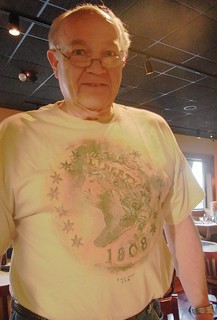 Nummis Nova met yet again on Tuesday, which is date night for some, who are now in the dog house for going out with the boys instead. Bonefish Grill in Chantilly on a Tuesday night was crowded and the table snug, but the seafood was excellent. Our theme for the evening was a doubleheader, due to co-sponsorship by Steve Bishop and Tom Kays. “Wearable numismatics” was my idea. I thought we might see coins used as buttons, pins, necklaces, bangles, but money designs printed on T-shirts was what turned up and it all worked for me. Here Mike models a fancy EAC cotton T-shirt, “Liberty in Copper,” being definitely the most distinguished and wearable numismatic regalia of the evening, and worn with charisma and good “sense” (on both the front and flip side).
Nummis Nova met yet again on Tuesday, which is date night for some, who are now in the dog house for going out with the boys instead. Bonefish Grill in Chantilly on a Tuesday night was crowded and the table snug, but the seafood was excellent. Our theme for the evening was a doubleheader, due to co-sponsorship by Steve Bishop and Tom Kays. “Wearable numismatics” was my idea. I thought we might see coins used as buttons, pins, necklaces, bangles, but money designs printed on T-shirts was what turned up and it all worked for me. Here Mike models a fancy EAC cotton T-shirt, “Liberty in Copper,” being definitely the most distinguished and wearable numismatic regalia of the evening, and worn with charisma and good “sense” (on both the front and flip side).
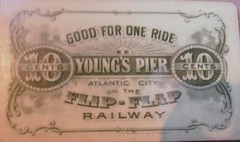
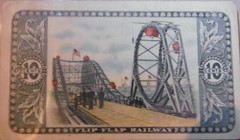
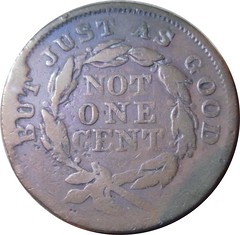 Mike continued along a parallel theme of “funny money” with this 1855 copper “Not One Cent – But Just As Good” token. It is dry humor, with a big cud at the “but” and about as funny as money gets. Think you can do better? Send your best numismatic joke to the editor and we’ll all have a laugh, perhaps at the April Fools edition of The E-Sylum.
Mike continued along a parallel theme of “funny money” with this 1855 copper “Not One Cent – But Just As Good” token. It is dry humor, with a big cud at the “but” and about as funny as money gets. Think you can do better? Send your best numismatic joke to the editor and we’ll all have a laugh, perhaps at the April Fools edition of The E-Sylum.

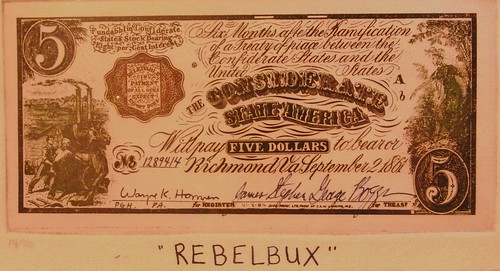

Wayne Herndon, Gregg Coburn, Jon Radel, Wayne Homren, Eric Schena, Dave Schenkman, Gene Brandenburg, Aaron Packard
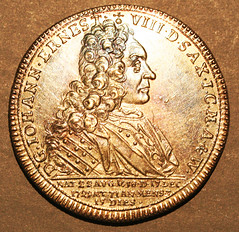
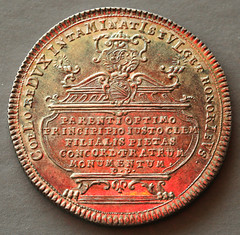
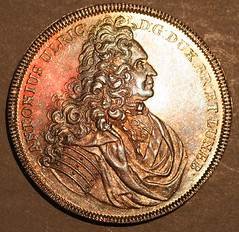

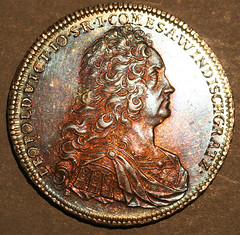
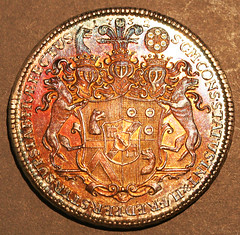
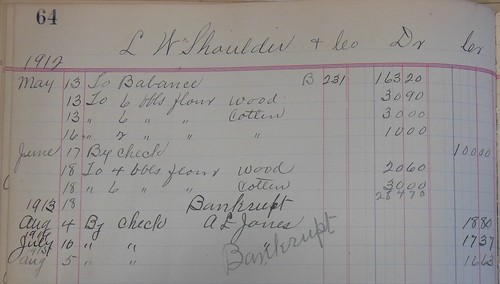
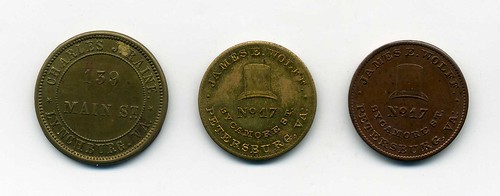
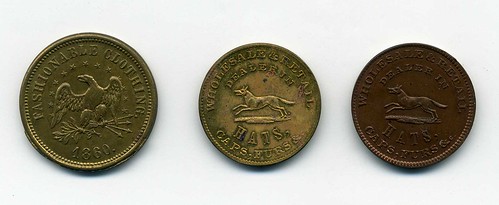
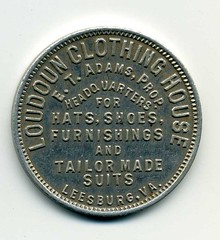
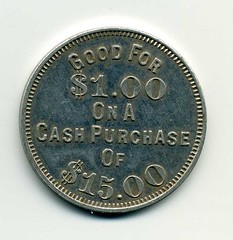
DICK JOHNSON ON DIVIDING A FAMILY COIN COLLECTION
THE BOOK BAZARRE
THE NUMISMATOURIST REPORT: MARCH 16, 2014
 It’s 2014 and The Numismatourist is traveling.
It’s 2014 and The Numismatourist is traveling.
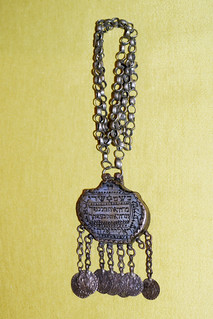 Currently, the museum is running a special exhibition about kame’ot (Hebrew, for amulets). Many religious Jews, especially those who believe in the Kaballah’s mysticism, use amulets of one kind or another to protect themselves from harm. Of the many kinds on display, two included coins attached to them. One is an early 20th-century amulet from Isfahan with silver Persian coins. There was also a small grouping of concentration camp money, which included notes from the Czech camp of Terezín (Theresienstadt), and coins and receipts from Poland’s £ódŸ Ghetto (Litzmannstadt).
Currently, the museum is running a special exhibition about kame’ot (Hebrew, for amulets). Many religious Jews, especially those who believe in the Kaballah’s mysticism, use amulets of one kind or another to protect themselves from harm. Of the many kinds on display, two included coins attached to them. One is an early 20th-century amulet from Isfahan with silver Persian coins. There was also a small grouping of concentration camp money, which included notes from the Czech camp of Terezín (Theresienstadt), and coins and receipts from Poland’s £ódŸ Ghetto (Litzmannstadt).


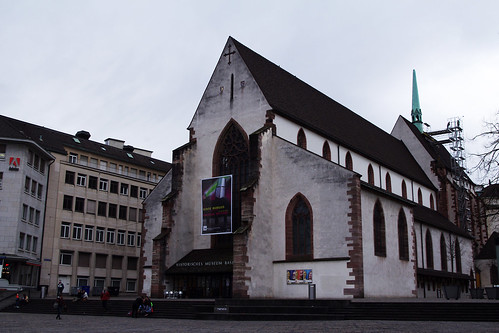

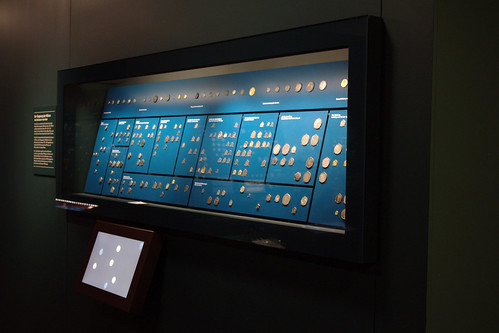
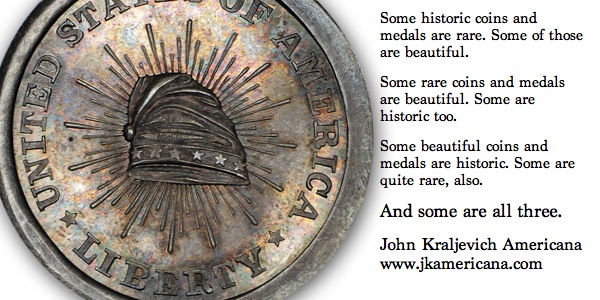
MAN CREATES U.S. MAP MADE OF 24,000 PENNIES
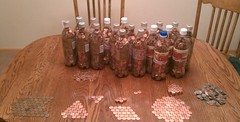 A Brooklyn Park man has mapped out a massive, coin-operated piece of “big crazy artwork” -- a U.S. map made of 24,000 pennies enclosed in glass.
A Brooklyn Park man has mapped out a massive, coin-operated piece of “big crazy artwork” -- a U.S. map made of 24,000 pennies enclosed in glass.
 Every time Ebert fills up one of the tubes with pennies, the camera clicks, making another frame in what will be a stop-motion video of Ebert’s “big crazy artwork”: a map of the United States made out of 24,000 pennies and enclosed in glass.
Every time Ebert fills up one of the tubes with pennies, the camera clicks, making another frame in what will be a stop-motion video of Ebert’s “big crazy artwork”: a map of the United States made out of 24,000 pennies and enclosed in glass.
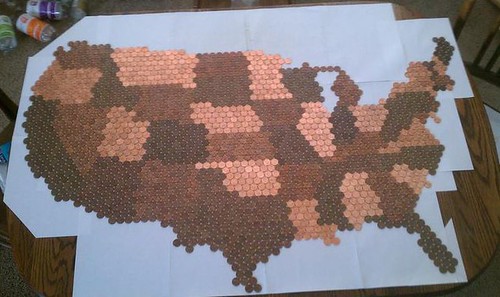
A color test
THE FIRST ELECTRICITY BILL: THOMAS EDISON'S DOLLAR
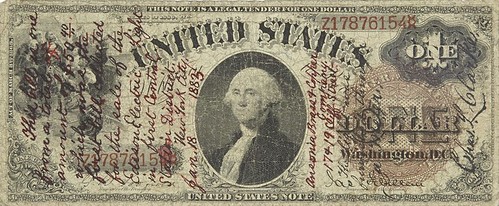
THE BOOK BAZARRE
BANK OF INDIA NOTES NOT IN ERROR

FAT PETE AND AUSTRALIA’S BIGGEST COUNTERFEIT MONEY OPERATION
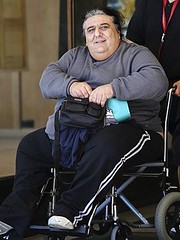 When Nicholas Megaloudis used two $50 notes to buy some burgers and fries at Hungry Jack’s in Sylvania, Australia’s biggest counterfeit operation began to unravel.
When Nicholas Megaloudis used two $50 notes to buy some burgers and fries at Hungry Jack’s in Sylvania, Australia’s biggest counterfeit operation began to unravel.
